The first cargo electric vehicles. Trolleys
The first electric cargo vehicle was trolley cars, which were powered by a contact network. In addition, they had the ability to move from traction batteries, and some models also had internal combustion engines, which provided such vehicles with autonomy. Most of the trolley cars produced in the USSR were equipped with traction electrical equipment from serial passenger trolleybuses.
Trolleys received mass distribution in our country precisely in Soviet times. But the first models of such electric transport were created back in the Russian Empire. It is known that the first domestic trolley car was made at the very beginning of the 1902th century - in XNUMX.
At the same time, two variants of such transport were presented in the USSR quite massively: cargo trolleybuses converted from passenger ones; and trolley cars, which were originally designed and built as freight transport. Most often, trolley trucks were created on the basis of existing or design models of trucks.
The appearance of the first trolley cars
History trolley trucks began back in tsarist Russia. In the magazine "Automobile" in 1902, an article was published about the tests of an unusual transport, which was set in motion by electric energy. The car received electricity from a contact wire network, which was located along its road. It is known that the vehicle was tested on March 26, 1902, this date can be called the date of the appearance of the first Russian trolleybus, and in fact - a trolleybus.
Introduced at the beginning of the XNUMXth century, the electric car did not look like the already well-known trams, as it moved along an ordinary road on ordinary wheels. Its main purpose was to transport goods. Its undercarriage was made at the P. Frese plant, and the electric drive was developed by Count S. Schulenberg. Information about this development, in particular, is found in the Russian journal Science and Technology.
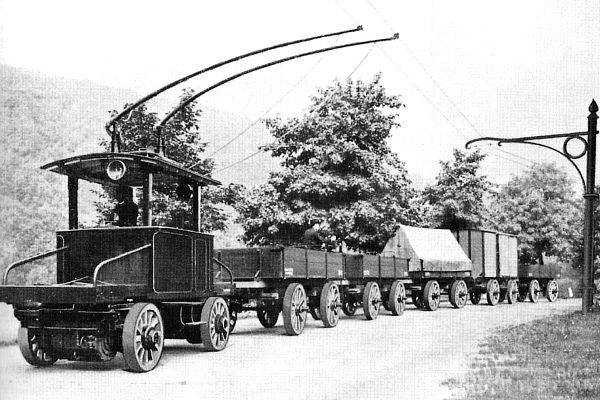
Freight train-trolleybus of the Monheim-Langelfeld trackless road (1904-1908), photo: wikimedia.org
A little later, in the period from 1904 to 1905, the Russian engineer V.I. Shubersky came up with a project to build the country's first trolleybus line. His project provided for the construction of the Novorossiysk-Sukhum route and was sufficiently worked out, but was never implemented, including due to a series of complex historical events that befell Russia.
For several decades, the ideas of building cargo trolleybuses were not in demand either. And the first trolleybus line was launched in the USSR only in 1933 and was located in Moscow. At the same time, in the 1930s, the country returned to the idea of building trolley cars that could show themselves in the national economy, including being used for the needs of emerging trolleybus parks.
The first Soviet cargo trolleybuses were made from ordinary ones by a simple alteration method with the cab in the front of the body and the addition of onboard cargo platforms. This technique was used primarily for technical assistance in the use of trolleybus lines. At the same time, the scope of their application grew as the number of cities in which a contact network appeared increased.
The first Soviet trolley car based on YAG-4
Around the beginning of the 1930s, a service line appeared in Moscow even before the start of operation of passenger trolleybuses. A cargo trolley car, built in 1936 at the Dynamo plant named after Kirov, managed to work on this line. The truck of the Yaroslavl Automobile Plant - YAG-4 acted as a base for the trolley car. It was a serial pre-war heavy truck with a carrying capacity of five tons.
When building a cargo trolleybus, its chassis and body were borrowed. Own weight of this model reached 7,8 tons. All additional equipment and current collectors were located in the front of the body, for this reason, in the empty state, a strong overload of the front axle was recorded. The trolley car based on the YAG-4 was completed with the DTB-60 electric motor, which was mounted under the cab on the frame. It was a DC motor that delivered 60 kW of power.
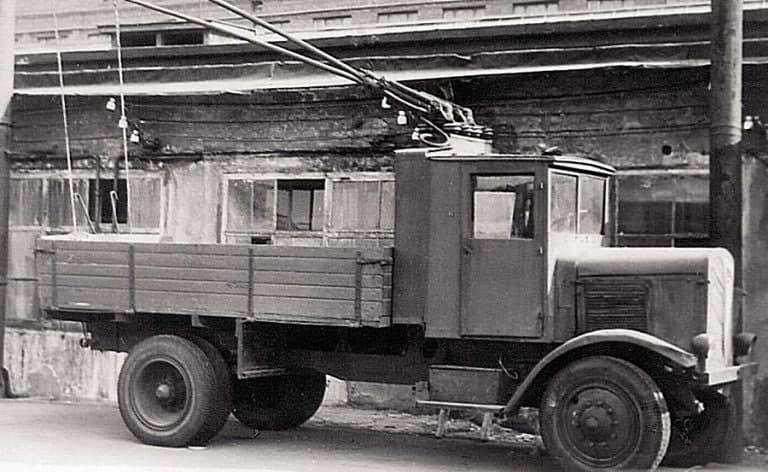
Trolley carrier YAG-4 in Moscow, photo: http://www.gruzovikpress.ru
The advantage of this machine was that it also received a 200 W ETT-120 battery, manufactured at the plant named after. Lieutenant Schmidt. The weight of the battery was an impressive 1,5 tons. The disadvantage was that it was not recharged while moving through the contact network, so it had to be recharged from the usual network, taking out containers weighing 750 kg each. Later, a special grounding cable was mounted on the trolley car, which allowed the vehicle to move along the lines of the electric tram.
Due to the large overload, the front axle of this trolley car was additionally reinforced. At the same time, the car was still overloaded, its carrying capacity fell to two tons compared to a serial truck. For this reason, and also because of the reduced operating speed, the model remained experimental.
Wartime freight trolleybuses
Since the late 1930s, in Moscow, on the personal initiative of I.S. Efremov, who served as director of the Second Moscow Trolleybus Park, the first mass-produced cargo trolleybuses in the USSR were designed and built. They installed additional sets of batteries, as well as significantly longer trolleys than on passenger versions. Such a move allowed cargo models to deviate from the contact network by 6-7 meters, which greatly simplified maneuvering in the city, as well as unloading and loading operations.
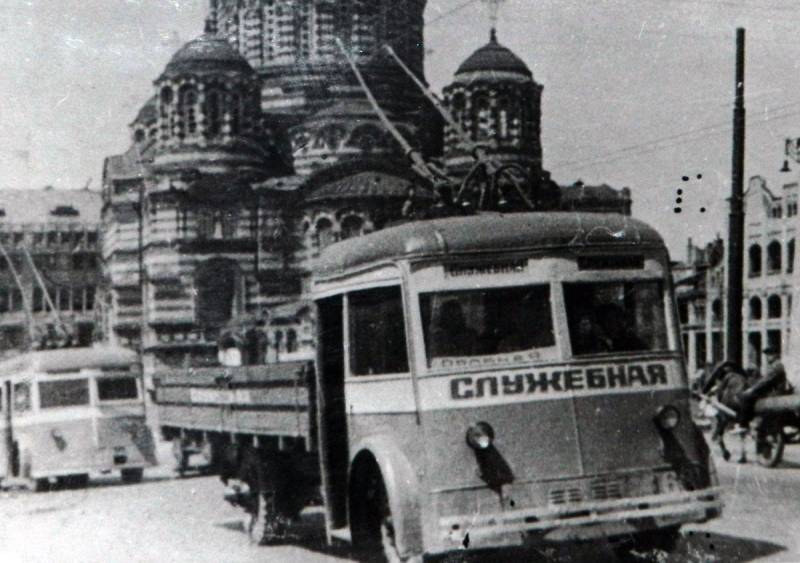
Cargo trolleybus based on YaTB-2 in Kharkiv, photo from the archive of the Kharkiv enterprise "Gorelectrotrans"
YATB serial cargo trolleybuses were converted into trolleybuses. So, in 1939, in the workshops of the Yaroslavl Automobile Plant, serial production of YATB-4 freight trolleybuses began, and already in 1941, two newer models, YATB-4a and YATB-5. The weight of these trolley cars reached 8 tons, and the maximum speed reached 40 km / h.
During the Great Patriotic War, trolley cars did not stand idle. Moreover, part of the Moscow trolleybus fleet was converted into freight transport, as it was necessary to fill the shortage of trucks mobilized into the army. Alteration work began already in the summer of 1941, when the shortage of automotive equipment in Moscow transport enterprises became obvious.
During the alteration, damaged and previously decommissioned YATB passenger trolleybuses were also used. All of them were converted into simplified trolley cars, which were often equipped with cabs of various sizes and a wooden body. They could also tow two-axle trailers behind them. All these cargo trolleybuses took part in supplying the city with everything necessary. During the war years, a cargo trolleybus line was even specially laid along the Leningradskoye Highway towards the cargo Northern River Port.
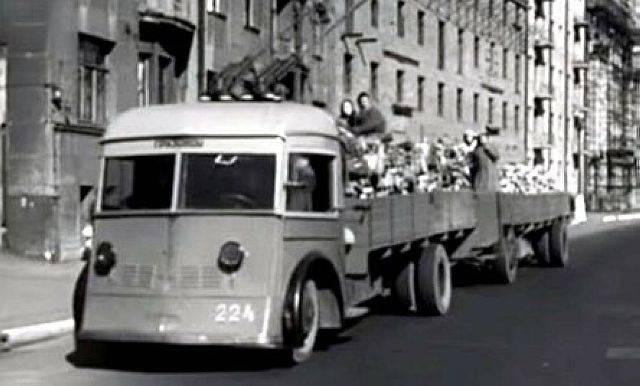
Cargo trolleybus based on YaTB-1 with a trailer, chronicle frame
It is believed that at the end of the war there were 61 cargo trolleybuses in Moscow. Also, a similar transport was used in Leningrad. In the capital, the number of freight trolleybuses began to decrease rapidly since 1946. That year, more than half of them were used as a repair fund for the construction of new Soviet trolleybuses MTB-82 and MTB-82A. In addition, as vehicles were demobilized from the army, the need for trolley cars almost completely disappeared.
Post-war models of trolley cars reached the quarries
Again, the idea of mass construction of trolley cars, but already at a new technical level in the USSR, returned in the 1950s and early 1960s, when a huge number of different models of such vehicles were created in the country. One of the most popular and successful was the vehicles of the SVARZ plant, which became real hybrids of economical trolleybuses and trucks.
The hallmark of the plant was the five-ton trolley trucks TG-3 and its subsequent modification TG-3M, which ran along the roads of many Soviet cities. The basis of the model was a welded spar frame, on which a high metal van body was mounted. The TG-3 trolleybus housed electrical equipment from serial MTB-82D passenger trolleybuses with an electric motor that developed a power of 80 kW, in addition, it also had a gasoline engine.
The gasoline engine was used when driving along the highway without a contact network, as a motor on the TG-3 there was an engine of the GAZ-51 type with a capacity of only 75 hp. With. This significantly limited the speed of the heavy machine. On the upgraded version of the TG-3M, the electrical equipment was replaced with traction equipment from the ZiU-5 passenger trolleybus, the power of the traction engine increased to 95 kW.
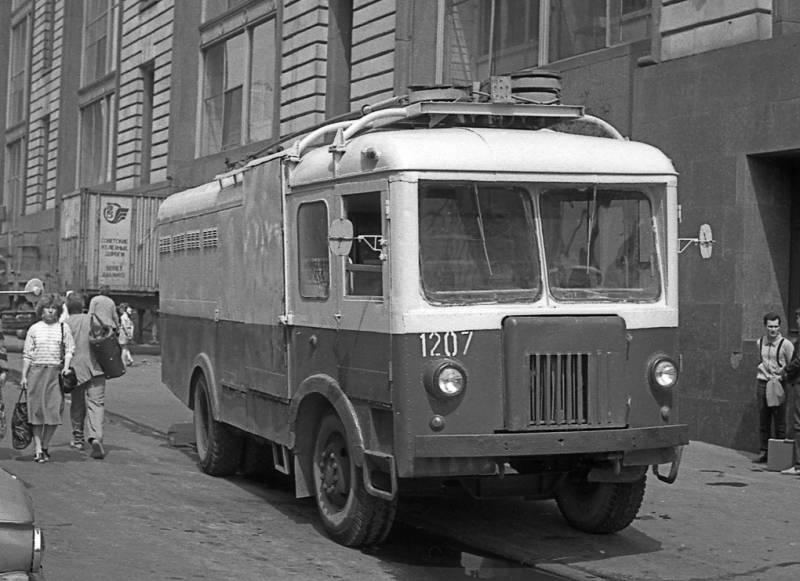
Trolleyvoz TG-3M in Moscow, Rozhdestvenka street. Photo: Alexander Shanin, https://ttransport.ru/amp/photo/161618.html
Serial assembly of the TG-3 model began in 1961, and Moscow became the largest operator of such equipment, which received more than 400 units of such vehicles. Also, this freight transport was actively used in many cities of Ukraine: Kiev, Odessa, Kharkov, Lvov and others.
In addition, attempts were made in the USSR to create trolley carriers based on heavy freight transport. So, in the Crimea, for some time, a diesel trolley carrier DTU-10, created on the basis of a KrAZ-219 (4x2) truck, was operated. The total weight of the experimental vehicle was 23,5 tons, the carrying capacity was 10 tons, the maximum speed reached 50 km / h. Tests of this machine were on the Simferopol-Yalta section.
Attempts were also made to create real mastodons that were supposed to work in quarries. At least three trolley cars were built on the basis of a quarry road train, they received the designation BelAZ-E524-792. Giants with a carrying capacity of 65 tons were tested in Kuzbass, but during operation, the further development of this direction was recognized as unpromising.
Practice has shown that the use of diesel trolley transport with maximum economic efficiency can only be carried out in quarries with a depth of at least 300 meters, while a permanent technical road with a small number of turns was required.
But if things did not work out in the USSR with the development and distribution of heavy cargo trolleybuses, then other electric cargo vehicles, primarily the TG-3M and numerous models of urban cargo trolleybuses, created on the basis of passenger ones, rode the streets of the cities of our vast country for decades.
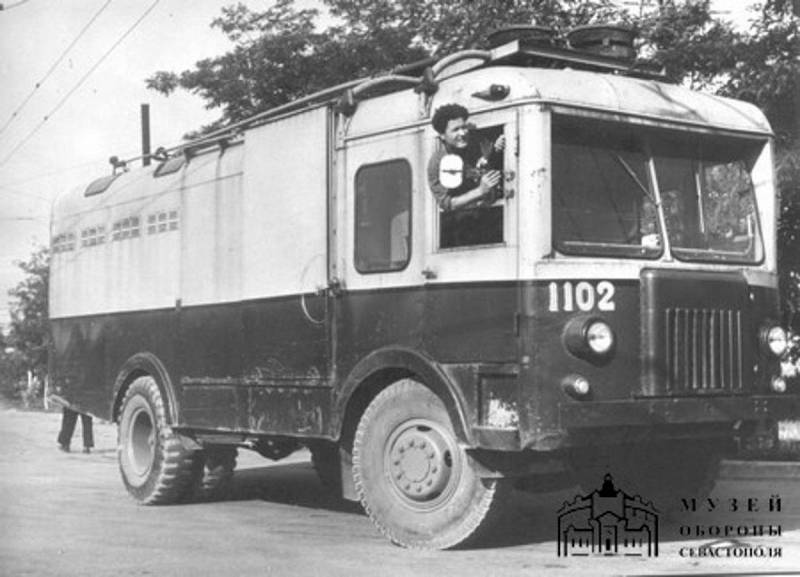
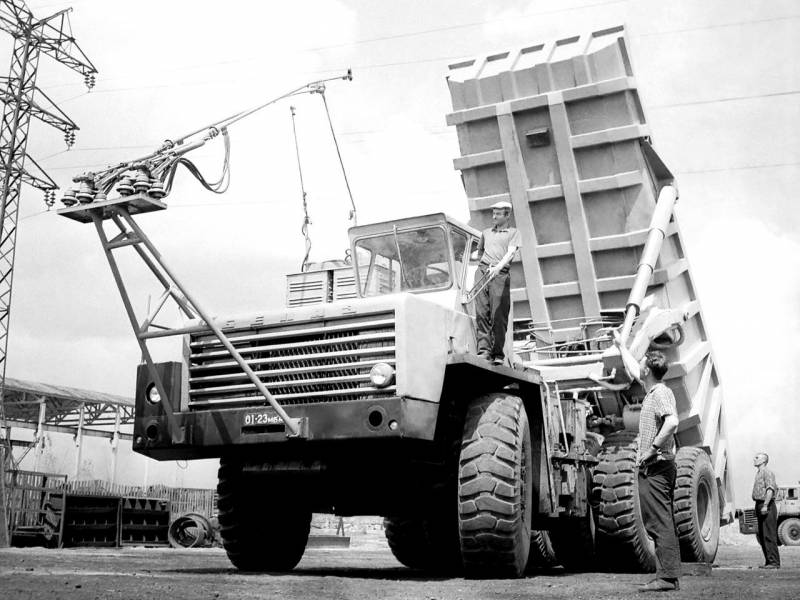
Information